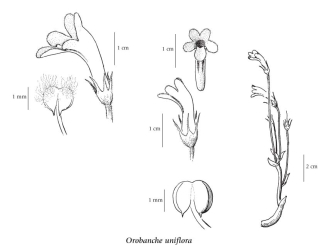Aphyllon uniflorum
naked broomrape
Orobanchaceae (Broom-rape family)
Introduction to Vascular Plants
naked broomrape
Orobanchaceae (Broom-rape family)
Introduction to Vascular Plants
Species Information
General:
Parasitic herb from a coarse, tuber-like, fleshy root; stems single or clustered, usually smooth except finely glandular-hairy above, 5-15 cm tall.
Leaves:
Basal leaves lacking; stem leaves scaly-bracteate, alternate, lance shaped, smooth.
Flowers:
Inflorescence of single flowers, 1-3 per plant; corollas purplish, sometimes yellowish, 1.5-3.5 cm long, the lips similar to the other lobes, finely fringed, stalked, the leafless stalks 3-12 cm long; calyces 4-12 mm long, the unequal, narrow lobes fringed; anthers smooth or hairy.
Fruits:
Capsules; seeds numerous, angled, net-veined, less than 0.7 mm long.
Illustration

If more than one illustration is available for a species (e.g., separate illustrations were provided for two subspecies) then links to the separate images will be provided below. Note that individual subspecies or varietal illustrations are not always available.
Illustration Source: The Illustrated Flora of British Columbia
Ecology
Ecological Framework for Aphyllon uniflorum
The table below shows the species-specific information calculated from
original data (BEC database) provided by the BC Ministry of Forests and Range.
(Updated August, 2013)
The table below shows the species-specific information calculated from
original data (BEC database) provided by the BC Ministry of Forests and Range.
(Updated August, 2013)
| Site Information |
Value / Class |
||
|
Avg |
Min |
Max |
|
| Elevation
(metres) |
857 | 31 | 1780 |
| Slope
Gradient (%) |
36 | 0 | 80 |
|
Aspect (degrees) |
216 | 50 | 340 |
| Soil
Moisture Regime (SMR) [0 - very xeric; 4 - mesic; 8 - hydric] |
1 | 0 | 5 |
| Modal
Nutrient Regime
Class |
C | ||
| #
of field plots species was recorded in: |
17 | ||
| Modal
BEC Zone Class |
ICH | ||
|
All BEC Zones (# of stations/zone) species was recorded in |
BG(1), CDF(2), CWH(2), ESSF(2), ICH(4), IDF(2), MS(3), PP(1) | ||
|
Source:
Klinkenberg 2013
|
|||
Habitat and Range
Parasitic on Sedum, Saxifragaceae, Asteraceae and others; moist to dry meadows and forest openings in the lowland, steppe and montane zones; common on SE Vancouver Island and Gulf Islands, infrequent eastward in S BC; E to NF and S to FL, TX and CA.Status Information
| Origin Status | Provincial Status | BC List (Red Blue List) | COSEWIC |
|---|---|---|---|
| Native | SNR | Not Reviewed | Not Listed |
BC Ministry of Environment: BC Species and Ecosystems Explorer.
Synonyms
Synonyms and Alternate Names:
Orobanche uniflora L.